Latest News
October 1, 2004
By Louise Elliott
The term “contract manufacturer” raises images of job shops and small specialty manufacturers. However, in the automotive, aerospace, and high-tech electronics industries, tiers of suppliers bid on huge, long-term contracts—often under pressure to come up with the lowest price. All too frequently, over the term of the contract they find that they can’t maintain their profit margins at the prices quoted.
The OEMs that contract for such work are under just as much pressure to produce new, reliable products quickly at the lowest price, so they can’t cut their suppliers much slack. Offering ways to solve such problems, digital manufacturing or manufacturing process management (MPM) technology that appeared to be cost-effective only for such OEMs, however, is now being targeted to their suppliers. The best-known products in the category are DELMIA from Dassault Systemes, E-factory from UGS, eMpower from Tecnomatix Technologies of Herzlia, Israel (which also partners with UGS), and Product Development Systems from PTC.
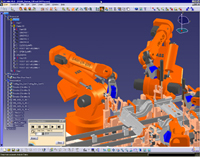
DELMIA’s digital manufacturing allows OEMs to define details from preproduction to final shop floor processes in the software. Manufacturers can then validate production before investing in equipment.
Chain Reaction“The best product in the world can be a loser, if someone else gets there first,” says Al Hufstetler, vice president of Business Strategy and Product Management for UGS. Using the automotive industry as a prime example, he says that OEMs contract out to tier one suppliers, who then contract out to smaller suppliers all over the world. “The OEM wants suppliers to look and feel almost like parts of their own organizations,” he says, “because subcontracted assemblies have to meet both internal and regulatory quality requirements and be tracked. This requires a great deal of collaboration with many different groups, and the tools for that collaboration.”
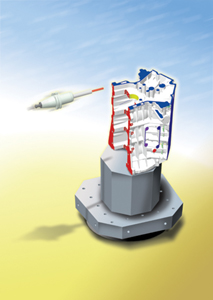 Automotive OEMs today want fewer plants, but more product lines in the ones that remain. “Flexibility has replaced old concepts of mass production, and ]they] need to think of plants as four walls with flexible tooling,” says Hufstetler. “That means they have to plan how products get put together.”
Automotive OEMs today want fewer plants, but more product lines in the ones that remain. “Flexibility has replaced old concepts of mass production, and ]they] need to think of plants as four walls with flexible tooling,” says Hufstetler. “That means they have to plan how products get put together.”
The OEM needs to know if the supplier can build the assemblies, produce them in the required quantities, and provide the same kind of documentation. The supplier needs to know that it can make money on the contract. MPM tools, although not yet capable of resolving all the issues involved, can now assist both sets of needs.
Aerospace issues are somewhat different from those of the automotive industry, because of the much longer lifecycle of most products. Process planning in aerospace deals with generating and defining work instructions for the shop floor, and providing a planned manufacturing environment through the product lifecycle—usually a matter of 40 years, says Deidra Donald, aerospace domain leader for DELMIA.
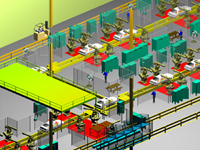
UGS’s E-factory includes manufacturing planning and shop layout tools, ergonomic/safety products, as well as productivity throughput capabilities.
“Manufacturing process management is as important for subsuppliers in their bidding process as it is for OEMs,” says Bob Axtman, director of Business Development for DELMIA. “It lets suppliers cut their proposals to the bare minimum and still maintain a profit margin and remain competitive.” It also speeds products to market by enabling tooling for known product groups to be undertaken before design completion.
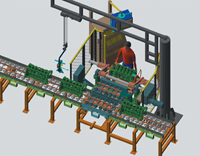
Using DELMIA’s digital manufacturing tools, GM was able to optimize and validate a new gauging process to help cut material handling by 60 to 80 percent.
“Not only are large suppliers hurting when trying to offer reasonable quotes that won’t harm their profit margins, but OEMs also experience similar difficulties when it comes to ‘engineer to order’ manufacturing,” says Alex MacKenzie, vice president of product strategy for PTC.
He points to another current manufacturing phenomenon—“white box outsourcing.” According to MacKenzie, “This occurs when the OEM tells a manufacturer to build a design in a particular way. Often in these cases, the OEM designs the process for the contract manufacturer, and it can occur when a contract comes back with too high a cost for manufacturing a particular design.”
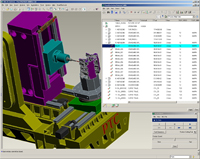
PTC’s Automated NC Process Planning functionality in Pro/Engineer means NC info is embedded in the model. When it gets to manufacturing , machining is ready to go.
The Tools of MPMA range of MPM tools now help OEMs and their subcontractors move toward designing for manufacturability (which greatly cuts down the number of change orders generated due to manufacturing difficulties), plan and build between 50 percent and 70 percent of tooling while the design process continues, lay out factory floors, simulate and program robotics, simulate whole production paths as the product moves from one manufacturing station to the next, and capture the information gained from each manufacturing cycle so that it can be applied to succeeding products.
E-factory includes manufacturing planning and layout tools, ergonomic products for safety, as well as productivity-throughput capabilities; this includes products and technology offered by Tecnomatix. The joint technology provides resource management, routing optimization, and movement of the product through manufacturing, including ancillary equipment. E-factory also works with product management tools, such as UGS’s Teamcenter PLM tools, although Hufstetler describes the system and CAD as PDM-independent.
The executive VP of Operations and Planning for a large automotive supplier that chose not to be named, says that E-factory tools combined with Teamcenter are helping his company to “see the day that design engineering and manufacturing engineering will become one…. There will be no difference.”
A manufacturing and quality IT manager for a large European automotive OEM calls E-factory “a powerful integrated solution …with tools and methodologies to improve communication, data sharing, and parallel working between product and process engineers, thereby reducing vehicle development costs and timescales.”
DELMIA describes its system as centered on ergonomics and safety, and compatible with multiple CAD and PDM programs. This Dassault Systemes company is the result of a merger of three companies: Safework, which makes human-factors software; Deneb, a provider of robotics programming software; and Delta, developers of digital process manufacturing software. “DELMIA solutions also allow users to validate and optimize a number of scenarios, including material flow, process engineering, layouts, and cycle times,” says Axtman.
Citing a planning time reduction of 40 percent for his company due to the iterative processes allowed by DELMIA tools, Dr. Thomas Wagner, of the German auto parts giant Robert Bosch GmbH, says, “Once considered a cost factor, this software is now viewed as a business opportunity that enhances competitiveness.”
Braced for AdvancementPTC’s Product Development Systems MPM products are not yet as advanced as those of UGS and DELMIA. PTC plans to take a two-level approach: a model-centric route for smaller manufacturers that have at least four seats of Pro/Engineer Wildfire; and another that’s PLM-centric with MPM tools integrated into Windchill, which will be a CAD-independent product. Currently, only the model-centric system is available.
Using tools inside Wildfire, the model becomes the basis of an associated process plan for manufacturing, which generates a work routing sheet. PTC is currently working with Toyota’s Power Train division to develop a library of manufacturing data that is associated to individual features in the model. Although the design engineer may be unaware that the data is built into his feature, the process planning engineer can access it immediately. The model-centric approach is PDM-independent.
Getting it right the first timeClearly MPM tools make a difference to OEMs and the suppliers to which they contract subsystem manufacturing. More capabilities are on the way to expand that universe.
DELMIA’s Axtman says his company provides “a collaborative environment where manufacturing can give feedback to design for realistic, cost-effective manufacturing. Manufacturers also need associativity back to product design if something changes in manufacturing.”
“Customers say they want out-of-the-box magic tools,” says UGS’s Hufstetler, “but the way they manufacture is an asset to them like intellectual property is to design. We can help them capture that knowledge into templates that let them assess each new job in terms of their own skills. Manufacturing is always expected to do more with less—this class of tools helps to change that.”
At PTC, MacKenzie sums up: “The future frontier is design for manufacturability and assembly. MPM offers a path toward the goal of having the design engineer and manufacturing engineer work concurrently and be knowledgeable, so that the design is right the first time. It means designs won’t get too far along and then be derailed by finding out it will cost too much to manufacture.”
Contributing editor Louise Elliott is a freelance writer based in California. Offer Louise your feedback on this article through Desktop Engineering Feedback.
For more on the products mentioned in this article, go to the online version at deskeng.com.
Companies mentioned:DELMIA
Dassault Systemes
delmia.com
Product Development Systems
PTC
ptc.com
eMpower
Tecnomatix Technologies, Ltd.
tecnomatix.com
E-factory
UGS
ugs.com
Subscribe to our FREE magazine, FREE email newsletters or both!
Latest News
About the Author
DE’s editors contribute news and new product announcements to Digital Engineering.
Press releases may be sent to them via [email protected].






